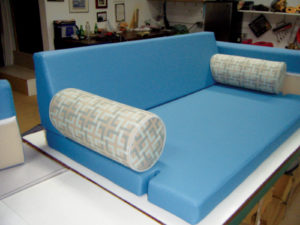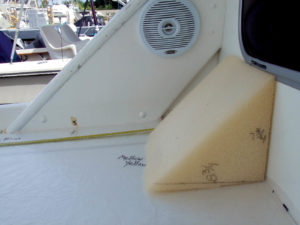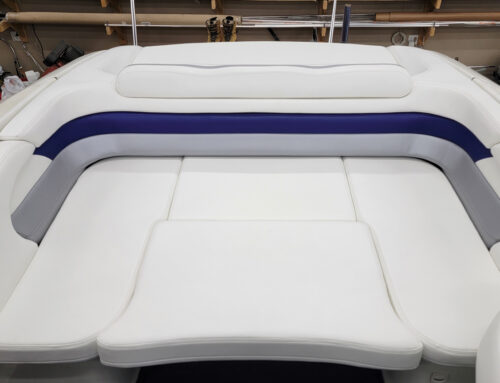Foam: The what, when and where
Cushion foam is an important component of any marine seating project. From cockpit cushions with hull angles to bosun’s chairs and boat mattresses, choosing the best solution for cushion foam is a bit of a science. The task can feel daunting given the complexity of choices in foam types, materials, densities and compression factors, but choosing correctly is crucial to a project’s success.
Foam types
Foam is essentially a group of air bubbles trapped inside a solid matrix.
Open-cell foam is characterized as a soft material. The surfaces of the bubbles (the cells) are broken and interconnected so that air moves easily through all the spaces of the material when the foam is squeezed or compressed.
Open-cell foam is ideal for cushioning, padding and backing for furniture when you are looking for a balance of comfort and support. It is also useful for occasional bedding products and is generally available at an affordable price in standard sizes and heights as well as cylinders and wedges. Polyurethane foam (polyfoam), memory foam and latex foam are the three most common types of open-cell foam.
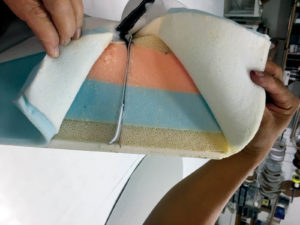
The original blue and pink polyfoam layers of this exterior cushion acted like a sponge absorbing water. These were replaced with fast-draining Dryfast foam.
Closed-cell foam is generally much denser and firmer than open-cell foam. Its air bubbles are completely sealed (closed) off from those around it. These materials typically have higher compressive strength, because the air does not dissipate when the foam is squeezed or pressed.
Closed-cell foam is often used in flotation equipment and marine products, because it does not soak up water. It is also resistant to solvents, petroleum products and has antimicrobial properties to prevent the growth of mold and mildew. I have rarely used it for seating cushions, because it is not comfortable to sit on. However, I recently noticed that West Marine utilizes closed-cell foam in their bosun seats for support. We recently supplied an expedition vessel with 4-inch x 96-inch laminated layers of closed-cell foam. The sheets had to wrap over the length of 96-inch carbon fiber poles for protection.
Factor in comfort
When choosing foam for your cushion project, you generally need a balance of comfort, support and durability that is appropriate for your application. I recommend you have different foam samples on hand so your customers can evaluate their preferences during “sit tests.” This is especially valuable when working on custom projects.
Support: The thickness of the foam will affect its ability to support weight. Consider the weight of the person being supported. A larger person (more than 250 pounds) will need firmer foam.
Comfort: The softer the foam, the more comfortable it will be. Adding a Dacron®/fiberfill wrap topper is an excellent way to add a bit of comfort while still having a good supportive foam. The fiberfill also helps in “filling out” the sides and edges of a firm foam inside of the cushion covers. Since fiberfill compresses easily, cut your foam to size without compensating for the fiberfill; otherwise, you’ll end up with a boat cushion that has a baggy appearance.
Durability: Higher density foams have a much higher resistance to collapsing or bottoming out than lower density, inexpensive foams. Applications in which a cushion is used onboard a vessel should lean toward a higher density. Seating that is used only occasionally could use a lower density foam.
Additional considerations
Cost will obviously be an important factor in your choice. The price for upholstery foam is based on sheets of a specific size and weight as well as density. Some vendors will offer custom cutting and pricing for upholstery foam if you do not need the large pieces they normally sell. Expect the price to be slightly higher per square foot than if you bought it in larger sheets and then cut it yourself. Upholstery foam can range from $12 a sheet (sold in 24- by 24- by 2-inch sections) to more than $126 a sheet (sold in 6- by 24- by 84-inch sections).
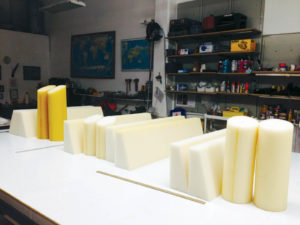
Dryfast foam is available in soft #30, medium #50 and firm #70 densities. It can be cut into numerous shapes and sizes.
Dryfast foam allows water to flow through it rapidly, making it ideal for exterior boat cushions as it does not retain water.Dryfast foam allows water to flow through it rapidly, making it ideal for exterior boat cushions as it does not retain water.
You will find out rather quickly that foam is available in various thicknesses. Also, some states have flammability laws that may lock you into using foam rated as fire resistant. Check with local and national suppliers for these requirements as well as samples, sizes, custom cutting options and pricing.
Ultimately, the “perfect” cushion foam for a given project depends on the primary use of the piece you are fabricating. Understanding an application’s requirements and your customers’ expectations is the best way to determine the ideal foam choice among the wide variety of options available.
Terri Madden owns Sand Sea & Air Interiors Inc. in San Juan, Puerto Rico. www.sandseaair.com.
 TEXTILES.ORG
TEXTILES.ORG 


